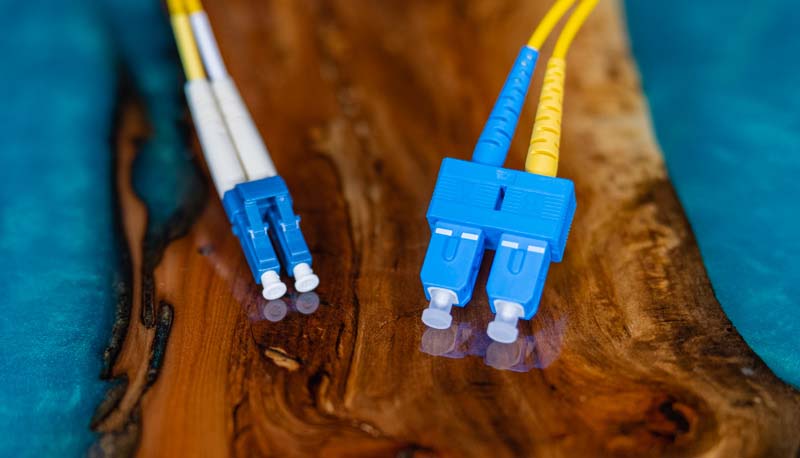
Fiber optic connections have become increasingly important in the world of telecommunications, data centers, and security systems. With its fast speed, immense capacity, and superior security, fiber optics is revolutionizing the way we exchange information.
Understanding how fiber optics work, the different types of cables available, and the application for these cables is essential for staying up to date in the world of telecommunications. By understanding the basics of fiber optics, we can better understand how the technology works and its implications in our lives.
From large data centers to individual home security systems, fiber optics provide a reliable, secure connection with immense capacity. This article will provide an overview of fiber optics, the different types of cables available, and the applications for these connections.
Connections that use fiber optics are transmissions that use glass fibers to transmit light signals. These connections offer immense speed and capacity and are more secure than traditional copper wire connections. Optical fiber networks are the backbone of internet connections, and are also used in telecommunications, data centers, and security systems.
Fiber optic connections use a core of glass surrounded by plastic or a protective material. The core of the fiber acts as a waveguide, transmitting light and enabling the connection. The light is sent through the core until it reaches a cladding layer surrounding the core. The cladding keeps the light from escaping the core and prevents contaminants from entering the core.
The light then travels through the fiber until it reaches an optical connector where it is then transferred to another fiber, or to a copper wire for use in a telephone or computer network.
Fiber optic connections provide immense speed, capacity, and security when compared to traditional copper wire connections. The speed of fiber optic connections is one of their most attractive features. With speeds up to 1,000 times faster than those of traditional copper wire connections, fiber optics is revolutionizing the way we transfer information.
The immense capacity of fiber optic connections is another attractive feature, providing the ability to transmit large amounts of data at once. The security of fiber optic connections is another benefit when compared to copper wire connections. Optical fiber is less susceptible to outside interference and electromagnetic interference, making it a more secure option when it comes to transmitting data.
Fiber optic cables come in two different types:
Multimode cables are used for shorter distances, while single mode cables are used for longer distances. Multimode cables use a larger core that can be seen with the naked eye and is used for shorter distances. The larger core allows for a wider beam of light, allowing for the connection over a shorter distance.
Single mode cables use a narrower core that cannot be seen with the naked eye and is used for longer distances. The narrower core allows for a more concentrated beam of light, allowing for the connection over longer distances.
Telecommunications is one of the largest industries that uses fiber optic connections. Telecommunications companies use fiber optic connections for core networks, and for access networks at end user’s locations.
These networks are used to transmit voice and data and are used in a variety of situations including house telephone systems, internet service providers, and cellphone towers. End user’s telecommunications systems also use fiber optic connections.
In the end user’s home, fiber optic connections are used in telephone systems and cable TV networks. In offices and other commercial buildings, fiber optic connections are used in computer networks. In telecommunications systems, fiber optic connections are used in the backbone, or core of the network.
Fibers are also used in the access network, where they connect buildings to the core network.
Data centers are large commercial buildings that are used to store and process large amounts of information. Data centers use fiber optic connections to transmit large amounts of data, and are used in banking institutions, health care, government agencies, and technology companies.
Data centers use fiber optic connections for their immense speed and capacity, as well as their security. Fiber optic connections are used in the connection from the data center to the internet, called the internet edge. These connections transmit large amounts of data and are used for internet service providers.
Fiber optic connections are also used to transmit large amounts of data within the data center. These connections are used for the connection between data storage devices and the computers that operate them.
Security systems use fiber optic connections to transmit information such as audio and video signals. In a house security system, fiber optic connections are used to transmit information between the various components of the system.
In a building security system, fiber optic connections are used to transmit information between the systems at the entrance and the security office. Security systems use fiber optic connections for their immense speed and capacity, as well as their security. In a house security system, fiber optic connections are used to transmit audio and video signals that are used to monitor the house and its exterior.
In a building security system, fiber optic connections are used to transmit signals between sensors placed at the entrance of the building and the security office.
Fiber optic connections are essential for transmission of large amounts of data at high speeds. These connections use glass, are more secure than copper wire connections, and are used in telecommunications, data centers, and security systems. Fiber optic connections are revolutionizing the way we exchange information and are essential for keeping up with the ever-growing demand for data transfer.
The Global Fiber Optic Connectors Market size is expected to reach $9.5 billion by 2028, rising at a market growth of 9.4% CAGR during the forecast period.